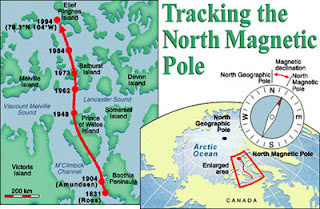TRUE NORTH
True north is the direction beside the
earth’s surface in the direction of the geographic North Pole. It is also
called geodetic north. True north is the point on the glob that is exactly 90
degrees north of the equator. We can
measure true north by which earth’s rotation axis meets the surface. Another
name for true north is GEOGRAPHIC NORTH. Geographic north is the direction that
we use in pas which is always same. It won’t change over years. True north is
an imaginary straight line which is passes among you and geographical pole on
the globe. PHYSICAL NORTH is where we are facing into it. any direction that we are facing will be our north which is changeable.
MAGNETIC
NORTH
The magnetic north is the direction that
the north-seeking arrow of a compass points. The magnetic north pole is the
northern pole of the earth’s magnetic pole which changes over year. It is
located 82.7 degrees north latitude. Since magnetic pole is the direction that
your compass points thus you must adjust your compass accordingly. Magnetic
pole is the point where the magnetic field are vertical and enters the earth.
There is always angular difference between true north and magnetic north. This
difference is called declination. Every five years there is an update for
magnetic north for the reason that it’s not stable. This can be observed by
looking at the rocks around the places where the sea floor is spreading.
Changing of magnetic pole is very gradual, last time that magnetic pole
switched was about 730,000 years ago. The difference between GN and MN is
important when you are using compass. In western territories the difference
among them is about 98 degrees, while in Toronto in about 9 degrees west of
north however in Churchill is 0 degrees. In Alaska there is a huge difference
between GN and MN. In 2005 the difference between GN and MG was about 810 km.
One of the
important fact about magnetic north is that, when people call is “magnetic
north” it’s actually south pole of the earth, the reason of that is because of
earth’s magnetic field.
different magnetic north in different years
REFERENCE
Abbr , N. (2000). magnetic north . In the free dictionary. Retrieved februray 23, 2013, from http://www.thefreedictionary.com/magnetic+north.
Goodman, J. (2001). Magnetic North Pole vs. Geographic North Pole. In science and science teaching . Retrieved february 21,2013, from http://www1.appstate.edu/~goodmanj/4401/notes/magnets/mnvsgn.html.
("True north copmare to magnetic north",2000). In answer.com. Retrieved february 22,2013, from http://wiki.answers.com/Q/What_is_true_north_compared_to_magnetic_north.
("Difference between true north and magnetic north", 2006) . In fun trivia. Retrieved february 23,2013, from http://www.funtrivia.com/askft/Question66680.html.
("Difference between true north and magnetic north in compass", 2013). In yahoo answer. Retrieved februray 23, 2013, from http://answers.yahoo.com/question/index?qid=20100428215956AA3qrhd.


